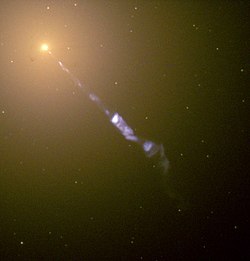Relativistic jet
Relativistic jets are very powerful jets of plasma with speeds close to the speed of light.[1] They are emitted by the central black holes of some active galaxies (notably radio galaxies and quasars), and by the black holes of massive stars and neutron stars. Their lengths can reach several thousand or even hundreds of thousands of light years.[2][3]
If the jet speed is close to the speed of light, the effects of the special theory of relativity are significant. The mechanics behind how jets are created,[4][5] and what they are made of, are still a matter of debate.[6] Jet composition might vary.[7][8]
Massive galactic central black holes have the most powerful jets. Similar jets on a much smaller scale develop from neutron stars and black holes in other stars. Even weaker and less relativistic jets may be associated with many binary star systems.
The general hypothesis among astrophysicists is that the formation of relativistic jets is the key to explaining the production of gamma-ray bursts. These jets have Lorentz factors of ~100 or greater (that is, speeds over roughly 0.99995c), making them some of the fastest celestial objects known at present.
Relativistic Jet Media
Illustration of the dynamics of a proplyd, including a jet
Centaurus A in x-rays showing the relativistic jet
The M87 jet seen by the Very Large Array in radio frequency (the viewing field is larger and rotated with respect to the above image.)
Galaxy NGC 3862, an extragalactic jet of material moving at nearly the speed of light can be seen at the three o'clock position.
Some of the jets in HH 24-26, which contains the highest concentration of jets known anywhere in the sky
References
- ↑ Wehrle A.E; Zacharias N. & Johnston K. 2009; et al. (2009). "What is the structure of relativistic jets in AGN on scales of light days?" (PDF). Astro2010: The Astronomy and Astrophysics Decadal Survey. 2010: 310. Bibcode:2009astro2010S.310W.
{{cite journal}}: CS1 maint: multiple names: authors list (link) - ↑ Biretta J. 1999. "Hubble detects faster-than-light motion in Galaxy M87".
- ↑ "Evidence for ultra-energetic particles in jet from black hole". Yale University – Office of Public Affairs 2006. 20 June 2006. Archived from the original on 2008.
- ↑ Meier, David L 2003 (2003). "The theory and simulation of relativistic jet formation: towards a unified model for micro- and macroquasars". New Astronomy Reviews. 47 (6–7): 667–672. arXiv:astro-ph/0312048. Bibcode:2003NewAR..47..667M. doi:10.1016/S1387-6473(03)00120-9. S2CID 16108597.
- ↑ Semenov V. et al 2004 (2004). "Simulations of jets driven by black hole rotation". Science. 305 (5686): 978–980. arXiv:astro-ph/0408371. Bibcode:2004Sci...305..978S. doi:10.1126/science.1100638. PMID 15310894. S2CID 1590734.
- ↑ Georganopoulos, Markos et al 2005 (2005). "Bulk comptonization of the cosmic microwave background by extragalactic jets as a probe of their matter content". The Astrophysical Journal. 625 (2): 656–666. arXiv:astro-ph/0502201. Bibcode:2005ApJ...625..656G. doi:10.1086/429558. S2CID 39743397.
- ↑ Wardle J.F.C. 1998 (1998). "Electron–positron jets associated with the quasar 3C279". Nature. 395 (6701): 457–461. Bibcode:1998Natur.395..457W. doi:10.1038/26675. hdl:11603/17540. S2CID 4413709.
- ↑ "NASA – Vast cloud of antimatter traced to binary stars".







